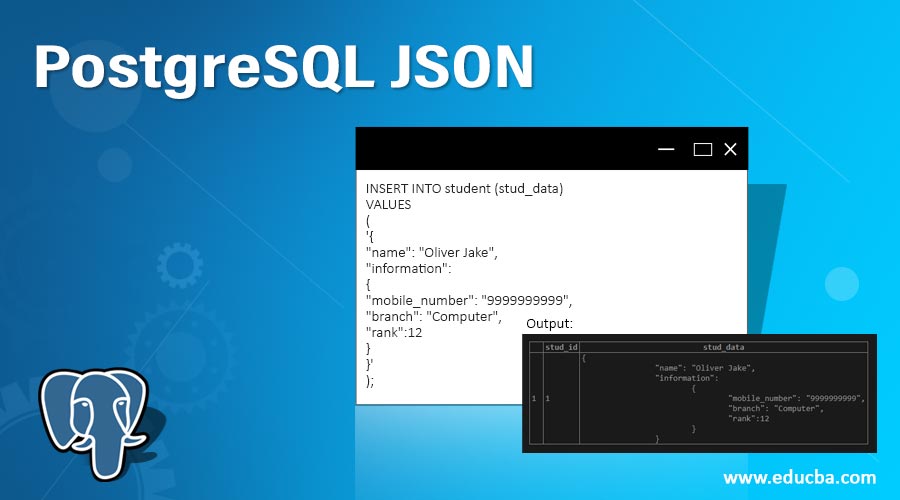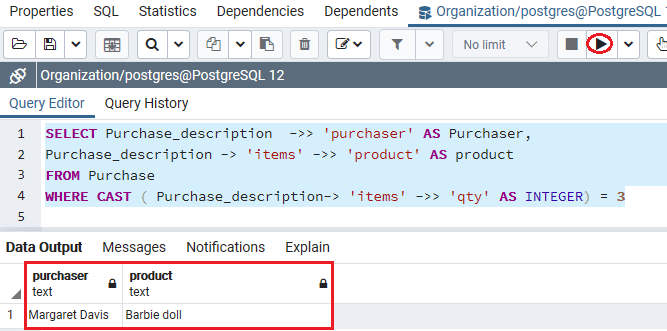
Locktype | transactionid | mode | granted Postgres=# SELECT locktype, transactionid, mode, grantedįROM pg_locks WHERE relation = 'events'::regclass

Postgres=# REINDEX TABLE CONCURRENTLY events PostgreSQL has a REINDEX command that rebuilds all indexes on a given table, but the REINDEX command takes a prohibitive lock in many production environments. To take advantage of the new B-tree format, indexes must be created on PostgreSQL 12. Depending on the data in the indexes, these improvements can result in some B-tree indexes being as much as 40% smaller on PostgreSQL 12.ĭatabases upgraded from an older version of PostgreSQL still have the older B-tree format. PostgreSQL 12 changes the logic of splitting B-tree index pages to use the context of duplicate index entries and uses some compression techniques.
#POSTGRES JSON QUERY FREE#
However, if the data has many duplicate index entries, splitting in the middle leaves a large amount of free space potentially unused. If the data being added to the table is somewhat random, splitting in the middle is ideal. In most cases, PostgreSQL splits those pages in the middle so that each newly split page has an equal amount of data and free space. When B-tree indexes grow, the data structures need to stay balanced so that when a particular leaf page becomes full, the page must be split. As tables grow, so do the corresponding indexes. B-tree indexes are used to index most types of data from integers that are primary keys to strings that are email addresses. In PostgreSQL, the default index type is a B-tree.
#POSTGRES JSON QUERY HOW TO#
I cover the benefits of these new features and show examples of how to adapt these features to existing applications. Others require changes to existing applications or processes to use them. Some of these features are transparent and simply upgrading to PostgreSQL 12 can leverage them. I explore how they can be incorporated into existing development and operational practices. In this post, I take a close look some of the exciting new features in PostgreSQL 12. PostgreSQL 12 introduces features opening up new development opportunities while simplifying the management of some already robust capabilities, such as new ways to query JSON data, enhancements to indexes, and better performance with partitioned tables. Today it is thus possible to store and process data in JSON format with high performance while enjoying the robustness and flexibility that PostgreSQL has habitually provided us with over the years.The PostgreSQL community continues its consistent cadence of yearly major releases with PostgreSQL 12. Using jsonb_path_ops operator class, PostgreSQL combines the elasticity of the JSON format at an amazing data access speed. With the introduction of the JSONB type and the GIN indexes This allows the above query to be run in just 0.167ms, with a performance increase of 650% compared to the original GIN index and 8% compared to the specific B-tree index initially used: all this without loss of generality with regards to the possible search operation. The resulting index occupies 46MB – only 22% of the size of the original data – and, thanks to its smaller size, it is used more efficiently by PostgreSQL. The syntax for creating this type of “optimised” index is as follows:ĬREATE INDEX on reviews USING GIN (review jsonb_path_ops ) In this case it is possible to use a different GIN index which only supports the operator and is therefore considerably smaller. In fact, it is often the case that the only operation used in the applications is the search for a subset.

The query takes approximately 1.100ms to be performed on the test machine, and the index that has been created is flexible and can be used for any search within the JSON data. The file, once unzipped, takes up 209MB and contains approximately 600k of records in JSON format with a structure similar to the following: ' GROUP BY 1 ORDER BY 2 The file customer_reviews_nested_ can be downloaded from the website of Citus Data. We will run our tests using the customer reviews data from Amazon for the year 1998 in JSON format.

It is useful to perform a number of tests to verify its actual performance. The 9.4 version of PostgreSQL introduces the JSONB data type, a specialised representation of the JSON data, allowing PostgreSQL to be competitive in managing the “lingua franca” of the moment for the exchange of data via web services. PostgreSQL 9 Cookbook – Chinese Edition.PostgreSQL Server Programming Cookbook – 2nd Edition.PostgreSQL 9 Administration Cookbook – 3rd Edition.PostgreSQL High Availability Cookbook – 2nd Edition.


 0 kommentar(er)
0 kommentar(er)
